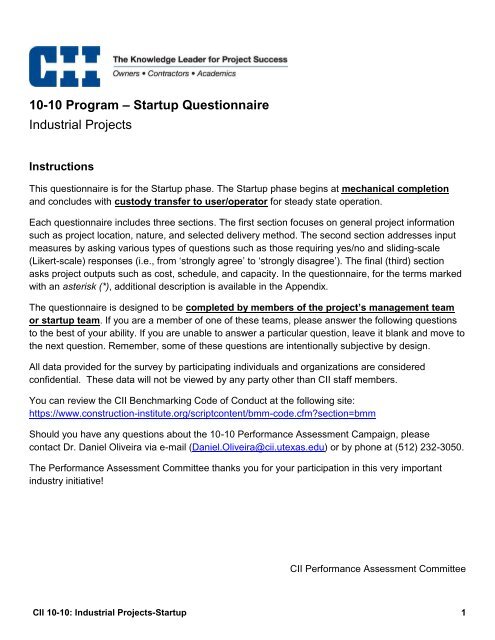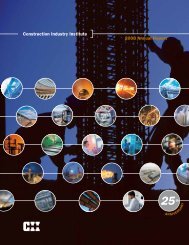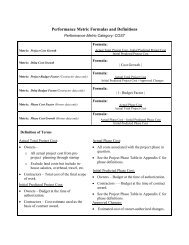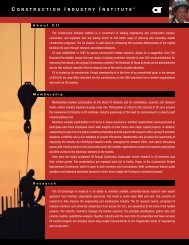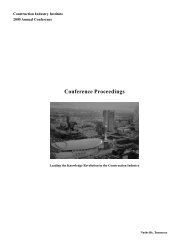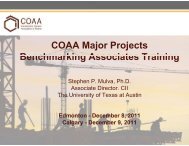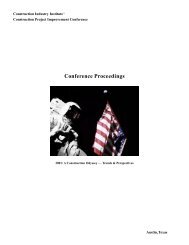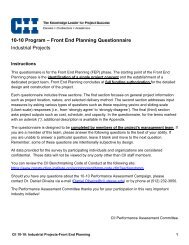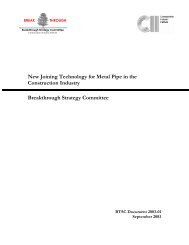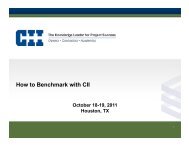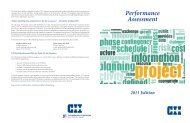10-10 Program â Startup Questionnaire Industrial Projects
10-10 Program â Startup Questionnaire Industrial Projects
10-10 Program â Startup Questionnaire Industrial Projects
You also want an ePaper? Increase the reach of your titles
YUMPU automatically turns print PDFs into web optimized ePapers that Google loves.
<strong>10</strong>-<strong>10</strong> <strong>Program</strong> – <strong>Startup</strong> <strong>Questionnaire</strong><strong>Industrial</strong> <strong>Projects</strong>InstructionsThis questionnaire is for the <strong>Startup</strong> phase. The <strong>Startup</strong> phase begins at mechanical completionand concludes with custody transfer to user/operator for steady state operation.Each questionnaire includes three sections. The first section focuses on general project informationsuch as project location, nature, and selected delivery method. The second section addresses inputmeasures by asking various types of questions such as those requiring yes/no and sliding-scale(Likert-scale) responses (i.e., from ‘strongly agree’ to ‘strongly disagree’). The final (third) sectionasks project outputs such as cost, schedule, and capacity. In the questionnaire, for the terms markedwith an asterisk (*), additional description is available in the Appendix.The questionnaire is designed to be completed by members of the project’s management teamor startup team. If you are a member of one of these teams, please answer the following questionsto the best of your ability. If you are unable to answer a particular question, leave it blank and move tothe next question. Remember, some of these questions are intentionally subjective by design.All data provided for the survey by participating individuals and organizations are consideredconfidential. These data will not be viewed by any party other than CII staff members.You can review the CII Benchmarking Code of Conduct at the following site:https://www.construction-institute.org/scriptcontent/bmm-code.cfm?section=bmmShould you have any questions about the <strong>10</strong>-<strong>10</strong> Performance Assessment Campaign, pleasecontact Dr. Daniel Oliveira via e-mail (Daniel.Oliveira@cii.utexas.edu) or by phone at (512) 232-3050.The Performance Assessment Committee thanks you for your participation in this very importantindustry initiative!CII Performance Assessment CommitteeCII <strong>10</strong>-<strong>10</strong>: <strong>Industrial</strong> <strong>Projects</strong>-<strong>Startup</strong> 1
Please briefly describe this project (i.e., what does the facility produce (?), what is its scope (?))II. Input Measures1. Was a turnaround involved in the scope of this project? ◘ YES ◘ NO(If yes) <strong>Startup</strong> was well integrated with the turnaround.Strongly Agree Agree Neutral Disagree Strongly Disagree◘ ◘ ◘ ◘ ◘2. What was the average startup management team* size (in FTE)?Ave. Team Size (in FTE)3. Please characterize how project meetings were conducted (check all that apply).◘◘◘◘Including appropriate representation of stakeholders, i.e., the ‘right’ people are presentEffective mechanisms for resolving project related issues (as measured by pre-planning, time,content, documentation, follow-up, etc.)Occurring with a frequency that meets the project’s needsHaving meaningful output that justifies my time investment.4. Which of the following statements characterized the decisions made by the manager(s) of this project?(check all that apply).◘◘◘◘◘◘Considered final and not revisitedCollaborative and inclusiveMade at the lowest appropriate level in the organizationCommunicated promptly to the teamMade in a timely and effective mannerConsistent with the delegation of authority5. Was there a written, <strong>Startup</strong>-specific safety plan for this project? ◘ ◘YesNoCII <strong>10</strong>-<strong>10</strong>: <strong>Industrial</strong> <strong>Projects</strong>-<strong>Startup</strong> 3
StronglyDisagree6. The owner level of involvement was appropriate. ◘ ◘ ◘ ◘ ◘7. A formal <strong>Startup</strong> execution plan including the impact to operations andmaintenance was implemented.◘NeutralStronglyAgree◘ ◘ ◘ ◘8. The <strong>Startup</strong> planning and scheduling processes were effective. ◘ ◘ ◘ ◘ ◘9. The <strong>Startup</strong> plan addressed community relations issues. ◘ ◘ ◘ ◘ ◘<strong>10</strong>. The <strong>Startup</strong> team had skills and experiences with similar projects / processes. ◘ ◘ ◘ ◘ ◘11. The project experienced an excessive number of startup management team*personnel changes.12. All of the necessary, relevant <strong>Startup</strong> team members were involved in aneffective risk identification and management process for <strong>Startup</strong>.13. <strong>Startup</strong> management team* members were clear about their roles and how towork with others during <strong>Startup</strong>.◘◘◘◘ ◘ ◘ ◘◘ ◘ ◘ ◘◘ ◘ ◘ ◘14. People on this project worked effectively as a team. ◘ ◘ ◘ ◘ ◘15. Key startup management team* members understood the owner's goals andobjectives of this project.16. <strong>Startup</strong> management team* members had the authority necessary to do theirjobs.◘◘◘ ◘ ◘ ◘◘ ◘ ◘ ◘17. Leadership effectively communicated <strong>Startup</strong> goals and priorities. ◘ ◘ ◘ ◘ ◘18. The key stakeholders were fully aligned before and during <strong>Startup</strong>. ◘ ◘ ◘ ◘ ◘19. <strong>Startup</strong> leaders were open to hearing "bad news", and they wanted input from<strong>Startup</strong> team members.20. Plan and progress including changes were communicated clearly andfrequently amongst project stakeholders.21. The project team members were familiar with the startup plan and they used itto manage their work.◘◘◘◘ ◘ ◘ ◘◘ ◘ ◘ ◘◘ ◘ ◘ ◘22. Resources were allocated according to <strong>Startup</strong> priorities. ◘ ◘ ◘ ◘ ◘23. A high degree of trust, respect and transparency existed amongst companiesworking on this project during <strong>Startup</strong>.◘◘ ◘ ◘ ◘24. The <strong>Startup</strong> processes and systems supported project success. ◘ ◘ ◘ ◘ ◘25. <strong>Startup</strong> management team* members had the information they needed to dotheir jobs effectively.26. Project leaders recognized and rewarded outstanding personnel and resultsduring <strong>Startup</strong>.◘◘◘ ◘ ◘ ◘◘ ◘ ◘ ◘27. The <strong>Startup</strong> met the operability and product quality objectives. ◘ ◘ ◘ ◘ ◘CII <strong>10</strong>-<strong>10</strong>: <strong>Industrial</strong> <strong>Projects</strong>-<strong>Startup</strong> 4
28. When issues arose, there were effective mechanisms to ensure they wereresolved.StronglyDisagree◘NeutralStronglyAgree◘ ◘ ◘ ◘29. A dedicated process was used to proactively manage change during <strong>Startup</strong>. ◘ ◘ ◘ ◘ ◘30. Regulatory requirements (e.g., permitting and environmental issues) wereproperly managed and <strong>Startup</strong> is in compliance.31. The project’s <strong>Startup</strong> processes were explicitly defined, managed, measured,and controlled32. The startup management team* members attended sufficient professionaltraining directly related to their work.◘◘◘◘ ◘ ◘ ◘◘ ◘ ◘ ◘◘ ◘ ◘ ◘33. The customer was satisfied with the <strong>Startup</strong> deliverables. ◘ ◘ ◘ ◘ ◘34. The cost of quality* was monitored during the <strong>Startup</strong> of this project. ◘ ◘ ◘ ◘ ◘35. Sustainability was an important consideration for the <strong>Startup</strong> of this project. ◘ ◘ ◘ ◘ ◘36. The project's process safety objectives were appropriately communicatedamongst the relevant startup management team* members.◘◘ ◘ ◘ ◘37. <strong>Startup</strong> safety procedures were well defined and strictly followed. ◘ ◘ ◘ ◘ ◘38. Pre-task planning (including safety) was regularly conducted by foremenand/or other <strong>Startup</strong> managers.◘◘ ◘ ◘ ◘III. Output Measures1. Please provide the actual total project cost and duration.Cost: $ Duration: weeks2. Please provide the total number of major equipment*.piece count3. Please provide the estimated and actual phase (<strong>Startup</strong>) start and end datesEstimated Schedule (mm/dd/yyyy)Actual Schedule (mm/dd/yyyy)Start Stop Start Stop4. Please provide the estimated and actual phase (<strong>Startup</strong>) cost.Estimated Cost ($) Actual Cost ($)CII <strong>10</strong>-<strong>10</strong>: <strong>Industrial</strong> <strong>Projects</strong>-<strong>Startup</strong> 5
5. What is the actual name plate capacity of the facility?Product NameName PlateCapacityUnit (e.g., tons/day, BOE/day)CapacityWhen <strong>Startup</strong> was complete, what percentage of name plate capacity was achieved?%6. What was the total number of <strong>Startup</strong> work hours?hoursCII <strong>10</strong>-<strong>10</strong>: <strong>Industrial</strong> <strong>Projects</strong>-<strong>Startup</strong> 6


